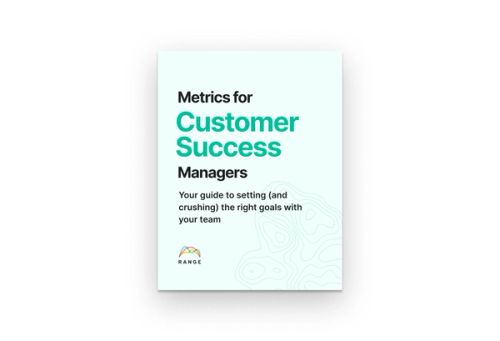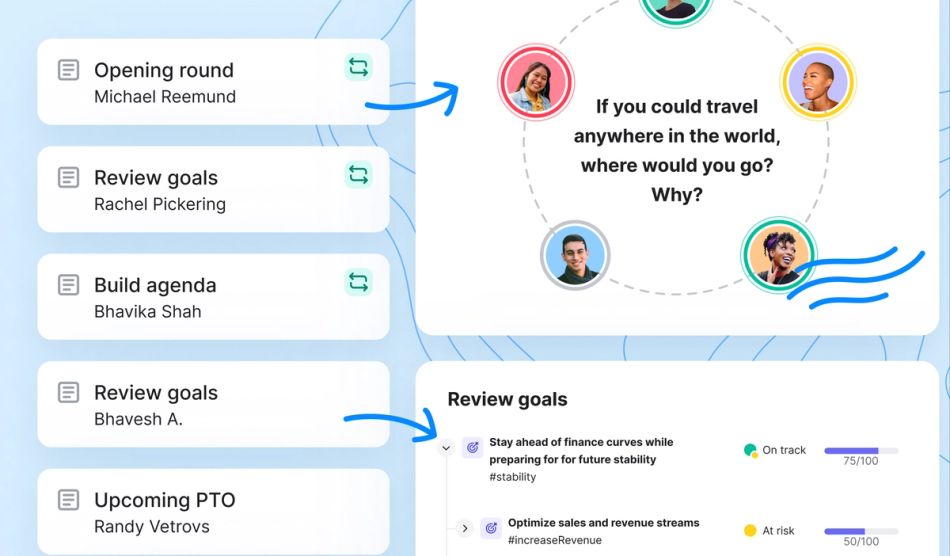A note to customer success leaders: your team rocks.
They’re responsible for the big stuff: product usage, retention, customer satisfaction, and — in at least some capacity — recurring revenue.
They’re the team closest to your customers, and they partner frequently with cross-functional stakeholders to elevate the customer voice. They spend their days nurturing relationships, problem-solving issues, and creating training and programs to make your product stick. It’s a job that requires patience, creativity, quick-thinking, solid business acumen, and top-notch communication. They’re all-stars responsible for all that and more.
So while your team is so deeply focused on the success of your customers and business, it’s your job to focus on theirs.
What success looks like—4 ways to best support your team
As a customer success leader, it’s your job to carve out the right goals and opportunities that will set your team up for success. It’s no secret that goals are critical to any team’s success. But that’s just the start of it.
From ideation to execution, here are 4 strategies to help your team set, follow through on, and crush its goals. (We’ll explore each of these deeper in the section below.)
- Guide your team to take on the right goals: Having numbers to hit helps us drive outcomes, rally the team, and show impact to stakeholders. Metrics keep us aligned and give us a north star work towards, especially when we’re remote or hybrid. But it’s not just about having goals—it’s about committing to the right ones.
- Normalize daily accountability: How do you keep goals top of mind and keep your team driving toward them like a well-oiled machine? It’s all about connecting daily work to the bigger picture.
- Talk about goals often: Your team should be rallying around goals and metrics on the regular. Not just a few times a quarter.
Lift up wins to stakeholders: Especially on a customer success team, where your work is so deeply intertwined to so many other parts of the business, lifting up wins to colleagues and stakeholders can be an opportunity to expand your influence and champion your (amazing) team.
Taking on the right goals and metrics
Getting super-intentional about what goals can *best* set your team (and customers) up for success can make a huge difference for morale, engagement, and outcomes.
Tips for choosing “the right” team metrics
- Don’t take on too much: This is a classic mistake that pretty much every team since the history of time is guilty of making at one point or another. But juggling too many goals all at once is a certain way to set yourself and your team up for failure.
- Focus on things you’ll work towards on a daily basis: If it’s not easy to connect daily work to the goal, it’s probably not the right one.
- Reflect on the past to plan for the future: Download our ebook of 150+ reflection questions for teams.
- Get feedback from your team: As a leader, it’s your job to guide your team down a path when it comes to goals. You’ve got the greatest oversight into what everyone's working on and jazzed about, plus context from leadership on the direction of the business. But since your team members are the ones in the trenches each day, having buy-in and excitement around them is 100% critical to their success.
11 customer success goals your team should care about
Let’s break down some of the most impactful customer success metrics. As a customer success team, you’ll want to think about goals across four key areas:
- Customer retention goals
- Revenue goals
- Product usage goals
- Customer loyalty goals
Customer retention goals
Customer success and retention go hand in hand — the more successful your customers are, the more likely they’ll stick around and continue using your product over time. Many teams use retention as a primary metric because it has such a powerful pay-off — a 5% increase in retention can produce a 25-95% increase in profit. And it’s more cost-effective — retaining existing customers over time is often 5x cheaper than acquiring new ones.
Here are a few metrics you’ll want to consider when measuring customer retention:
1. Customer retention rate
Customer retention rate measures the percentage of existing customers your business retained over a given period. In other words, from one month, quarter, or year to the next, how many of your customers stick around? To calculate customer retention rate, first choose your time period (month, quarter, etc.). Take the total number of customers at the end of that period (E) minus the total number of new customers (N). Then, divide that number by the total number of existing customers at the start of the time period (S) and multiply by 100 to get your retention rate.
Customer retention rate = [(E-N)/S] x 100
2. Customer churn rate
Churn rate is another way of thinking about retention, but focuses on the loss side of things. It’s typically measured as either the number of customers lost or the dollar value lost that those customers represent, over a given time frame. Your churn rate is calculated by the number of customers who churned divided by the total number of customers at the beginning of that time frame. So, using the same variables as above:
Customer churn rate = [(S-E)/S] x 100
3. Customer retention cost
Retention cost measures the financial investment required to retain each customer, and is a good way to measure whether or not your customer success efforts are yielding returns. Effective customer success teams grow customer retention in a greater proportion than the costs of their operation. To calculate your average customer retention cost, divide the total annual cost of your customer success team and initiatives (CS) by the number of active, current customers.
Customer retention cost = [$ spent on CS] / # of active customers
4. Customer lifetime value (CLV)
This key customer success metric takes into account a customer’s revenue value in comparison to your business’s predicated customer lifespan. It’s a great way to identify your customers or segments that are most valuable to the company — and then prioritize education and trainings, product updates, and other services to help retain them. You can look at your average customer lifetime value at a company level, by customer segment, or at the individual level for a single customer.
To calculate it at the company or segment level, you’ll need a few different inputs, including:
- Average purchase value (APV): Total $ value of all purchases over a particular time period (typically a year), divided by the number of purchases in that time period.
- Average purchase frequency (APF): Total # of purchases made in that same time period divided by # of individual customers who made purchases during that time.
- Customer value: APF x APV
- Average customer lifespan: Average length of time a customer continues buying from you
Customer lifetime value = Customer value x Average customer lifespan
To calculate CLV for individual customers, follow this formula:
Customer lifetime value = Revenue made from that customer in a year x the # of years they’ve been a customer — Cost of acquiring and serving them

Download the Metrics for Customer Success Managers Ebook
Save your own copy of our top tips for managing goals and metrics on your customer success team, plus 11 sample metrics to start prioritizing today.
5. Renewal rate
Customer renewal rate measures the percentage of customers who renew with your business at the end of each subscription period. It’s calculated by taking the number of customers who renew (R) divided by the total number of customers up for renewal (C).
Customer renewal rate = [R/C] x 100
Revenue goals
No matter what team you’re on, company revenue matters. Revenue growth = business growth, and it’s one of the most tried and true measures of success. While net new revenue often falls on sales teams — recurring revenue is all about keeping existing customers around and unlocking incremental value over time. Think: onboarding process, training programs, adoption programs for new features — these are all efforts your team focuses on that can contribute to revenue goals.
6. Monthly recurring revenue (MRR)
This key metric is a way to measure your business’ predictable revenue for each month. You can measure MRR by multiplying the average monthly revenue per customer (AR) by the total number of customers (C) you have that month.
Monthly recurring revenue = AR x C
Product usage goals
Customer success is often responsible for driving the adoption of new products — in particular among current customers — so product and feature usage metrics are key. Your team might create things like customer training programs, onboardings, or other educational materials to get users up to speed. Customer feedback also plays a big role here — and customer success is often responsible for collecting that feedback and passing it along to the product team to improve new features and inform additional features.
7. Product adoption rate
This is used to measure feature adoption of a new product or service over a given time period. You can calculate it by dividing the total number of customers who used the feature during your set period of time (CF) by your total number of customers during that same time.
Adoption rate = [customer who used feature / total customers] x 100
8. Daily active users (DAU)
The more often a customer uses your product, the more likely they are to get value out of it (and the more value they’ll provide to your business down the line too). DAU can give you a deeper insight into how sticky your product is and how customers engage with it. To measure DAU, simply count the total number of unique users or customers on a given day. You can also calculate your average daily active users by counting the total number of active sessions you’ve had over a time period — usually a month — and then dividing by the number of days in that month. (You can double count users with this method, so long as their visits were on different days.)
Average DAU = Total active sessions / days in that time period
Tip: Defining a DAU depends on your product. Definitions of “active” may differ from product to product. Ask yourself: what’s the minimum action a user needs to take to get value? For a messaging app, that might be sending one message. For an e-commerce store, that might be visiting the website or app and/or average session duration.
Customer loyalty goals
Customer loyalty goals should be top of mind for customer success leaders. In a world where customers have so many options to choose from, customer loyalty can make or break your business. Loyal customers stick around for the long haul — providing a reliable source of revenue, championing your brand to new users, and unlocking incremental value over time. When customers don’t feel a sense of loyalty to your brand or business, they’re more easily swayed when a competitor comes around.
So how do you know if your customers are happy? Customer loyalty goals can help you understand the effectiveness of your customer success strategies — identifying opportunities to better serve your customer base through things like customer loyalty programs, customer marketing, and education — and produce a greater number of happy customers overall.
9. Net promoter score
This metric is all about direct customer feedback. It’s based on customer responses (on a scale of 1-10) to a net promoter survey question: “How likely are you to recommend [business/product] to a friend or colleague?” Customers who respond 0-6 are “detractors;” 7-8 are “passives;” and 9-10 are “promoters.” After surveying customers, your net promoter score is calculated by the difference between the percentage of promoters and detractors.
Net promoter score = % of promoters - % of detractors
10. Customer satisfaction score
Similar to NPS, your customer satisfaction score is also based on customer feedback and the percentage or rate of positive responses. It’s measured by how customers rate their experience with your company or product. Where it differs from NPS, is that the questions you ask and rating scales can be customized to understand your customers’ level of satisfaction.
11. First contact resolution rate
First Contact Resolution rate can be useful in helping track and improve your customer success team’s efficiency.
First contact resolution rate = [Issues resolved on first contact / total issues] x 100
Tips and best practices for setting your goals
Goals + subgoals go hand-in-hand
Once you land on your highest level goals and metrics, you may want to choose a few sub-goals that ladder up into them. Sub-goals are a great way to break big, longer term goals into manageable parts. Especially if it’s something you’ll be tracking towards for a long time, sub-goals can give your team a sense of progress and accomplishment along the way.
Example:
Goal: Increase NPS score from 30 to 50
Sub-goals:
- Conduct phone interviews with at least 50% of churned customers
- Collect feedback from 50 customers on product improvements
- Post 4 education tutorial videos in our resource center
- Add 5 new help articles
For every goal, a clear owner
Most goals will be a team effort, but you’ll still want one person who’s directly responsible for each goal and subgoal so it doesn’t fall through the cracks. Assigning clear owners helps with accountability and ensures that work isn't duplicated by multiple folks on your team.
One source of truth to rule them all
Once you have goals and owners in place, you’ll want to make sure they’re all tracked in one place. This will give the whole team visibility into how things are going, builds greater accountability and excitement around the work, and makes it way less of a headache to keep track of how things are moving along. If something’s blocked or needs more resources allocated to it, tracking everything in one place ensures you’ll catch this early on and be able to pivot accordingly.
Learn how to create, assign, and track all your goals seamlessly with Range
Build daily accountability around goals and metrics
Once you’ve got your goals squared away, the next step is to build practices to help you track (and crush) them.
When it comes to actually making progress on goals, connecting them to daily actions is key. According to Stanford psychologist Kelly McGonigal, taking small daily steps that are in line with your goals is one of the best (research-backed) ways to work towards a goal over time. She says, “People often get lost thinking they have to change everything all at once [...] But small changes can pave the way for bigger changes.”
Take a moment to think through a week in the life of your customer success or customer experience team. Does everyone’s day-to-day work, for the most part, contribute to your big picture goals? If you asked a teammate how their work maps to quarterly goals and objectives, would they be able to answer? If not, building a daily accountability practice can help connect the dots.
Daily goal-tracking for customer success
Daily accountability means thinking about team goals every single day, not just at the beginning and end of the quarter or when some big milestone is approaching. High-performing customer success teams plan with the long-term in mind, and then use daily goal tracking to help keep everyone on track.
Building a practice of daily goal tracking gives CS managers (and everyone else on the team) more visibility into in-flight work. Everyone can see how work moves from point A to point B and managers can quickly step in and offer support if they need to. If something is off track, the team can spot it early and recalibrate.
Learn more about the benefits of daily goal trackingDaily goal-tracking doesn’t have to be a daunting task, either. I can be super lightweight—think, 5 minutes or less each morning. That’s probably less time than your team spends in a daily standup or status update meeting, and arguably way more valuable.
How to structure your status updates
There are a number of different ways you can approach daily goal-tracking. We recommend doing it asynchronously, so there’ll be a written record of everyone’s progress, which is especially valuable on a remote or hybrid team. Make sure the format is simple — we recommend the GROW format:
- Goal
- Reality
- Obstacles/Opportunities
- Wins
Tip: Track daily goals seamlessly in Range
Got 3 minutes? Range check-ins were built for fast, effective daily goal-tracking. They make it easy to share what you’re focused on and what you’ve accomplished in just a couple of clicks—and link back to docs, tickets, and other reference points for context. Prompts (https://www.range.co/blog/check-in-prompts) help folks know exactly what to share and #tags make goals and sub-goals searchable over time. Easily view the status of any goal on your team so you can see how things are progressing and steer things back on track.
Build a daily accountability practice in 5 minutes or less each morning with Range
Talk about goals often
Once you’ve got a daily goal-tracking practice in place, you’ll want to think through some intentional moments where you’ll come together and discuss how everything’s going as a group. This works best on a weekly or bi-weekly cadence—your goals won’t matter much if you only talk about them a few times a quarter.
Rather than add another meeting to the mix, try carving out a section of your existing customer success team meeting for this purpose.
As Help Scout CXO Mariah Hay shared in Range’s “How Teams Work” series, it’s important for customer experience teams to balance asynchronous and real-time communication, especially when working remotely. By making written documentation a priority, her team is able to avoid unnecessary meetings and save live discussion time for topics that can’t be handled async. Learn more
Ways to rally around goals in your customer success team meeting
- All-up progress review: Add a recurring agenda item at the beginning of the meeting to check in on progress. If you’re using Range, you can use the Goals integration tool to easily see everything that’s happened related to a given goal or subgoal.
- Collaboration time: Did folks flag anything as a blocker or for feedback throughout the week? Team meetings can be a great place to collaborate and work through that together.
- Celebration and gratitude: Celebrate progress towards your goals, and wins big and small. You might use the last 5 minutes of your meeting to go around and high five each other for specific progress made that week, or recognize folks for lending a hand or stepping up to see the work through.

Lift up wins to stakeholders and leadership
As a customer success team, you probably spend a lot of your time collaborating and sharing customer insights with cross-functional partners and leadership.
Looping these groups in on your team’s goals and progress towards them can be really valuable. Here’s why:
Benefits of sharing day-to-day progress with cross-functional partners + leadership
- Shows your team’s impact and the value you’re driving for the business
- Helps you make the case for more headcount and resources, and secure buy-in on new initiatives
- Helps your team set boundaries—when cross-functional partners know your team’s goals and objectives, it’ll be easier to say “no” to projects that don’t align with those objectives
- Gives individuals company-wide visibility and recognition for the work they put in
- Helps build empathy with collaborators outside of your immediate team who may not already understand the nature and extent of your work
How to share progress
Whether you're reporting up to company leadership or sharing your daily work with teammates and cross-functional colleagues, Range makes it easy to share progress on your customer success team’s goals.
Once you build a practice around daily check-ins, it’s easy to create custom reports on your team’s progress and share them with leadership and stakeholders. You can pull reports on a specific goal or sub-goal (using #tags)—and then share them over email or Slack in seconds.
Learn more about crushing your customer success goals with Range







